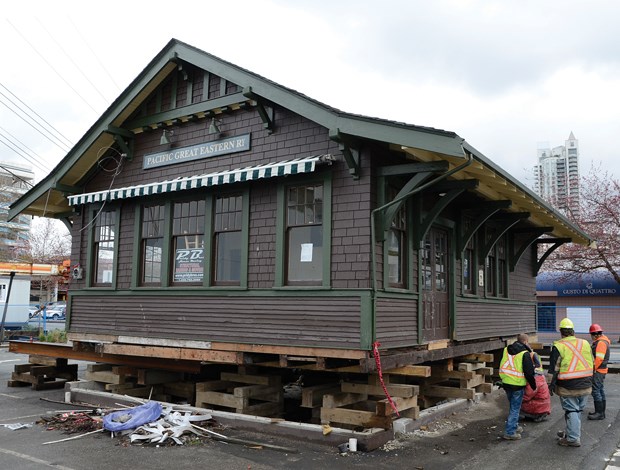The City of North Vancouver's historic Pacific Great Eastern railway building has, ironically, left the station.
The city contracted a firm to lift the 1913-station from its home at the foot of Lonsdale and move the historic structure to a temporary location on a vacant city-owned lot at 449 Alder St.
The foot of Lonsdale is about to be torn up for structural work to the subsurface. The area is pegged to be the site of a new Presentation House Gallery, a public plaza and an upgraded Spirit Trail.
Exactly what happens next with the building, which used to be where PGE Railway passengers would purchase tickets and wait for their train, will be up to council.
"There will be a couple of options for council," said Barb Pierce, the city's director of special projects. "One is to keep it on the site, not in the exact same location because that location is going to be right in the middle of the pathway for the Spirit Trail,. .. or finding another location within the city for it to be used."
Council will begin its debate on the future of the foot of Lonsdale, including the century-old station's fate, in May, according to Pierce.
In the last few years it was used as storage for the North Vancouver Museum of Archives and as a launching point for historical walking tours of the shipyards. It also spent some years in Mahon Park as a satellite location for the museum.
A study by Colliers International commissioned by the city suggested the PGE station could be converted into an ice cream shop, a coffee joint or a bicycle rental business as part of a redeveloped waterfront.
Any of those options would be fine with the North Shore Heritage Preservation Society, as long as the building comes home to its original (or close to it) location, said Peter Miller, society president.
"Without spoiling the actual building, all those things could happen with the existing windows and doors and roof. It would be quite charming, actually, sitting outside in the sunshine with a coffee," Miller said.
Buildings lose their heritage impact when they're moved to a new location with no connection to their original purpose, Miller said.
"It is a heritage artifact, which reminds people of the fact the railway was important and the bottom of Lonsdale was the intersection between the ferries and the railway," he said.



